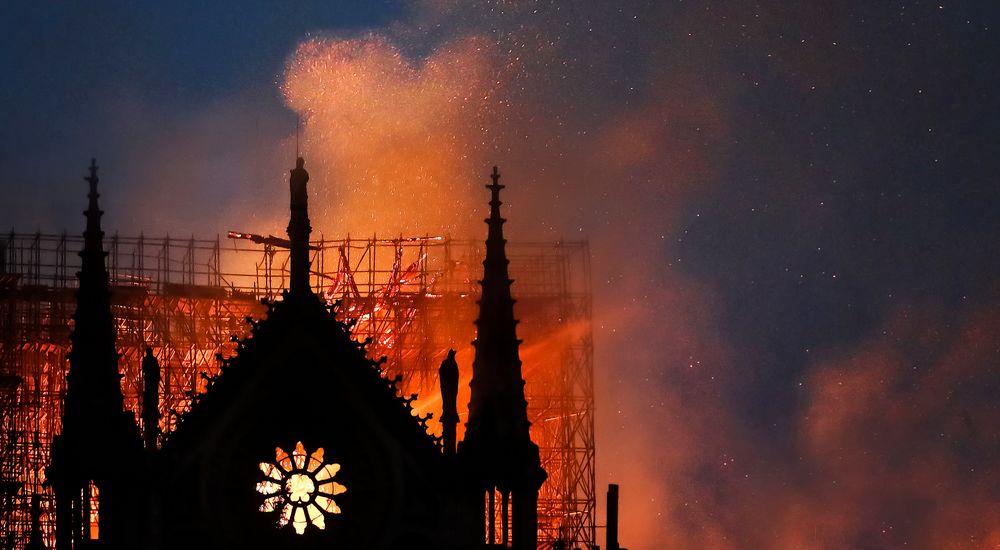Scientists are researching the fire-resistant properties of natural stone
Science is investigating the effects of high temperatures on natural stone with the main sector organisations.

CTMNC Engineer-Doctor and doctoral student Martin VIGROUX is investigating the effects of high temperatures on natural stone through scientific studies conducted with the main sector organisations. Although his research is still on-going, he revealed his initial findings in a conference at Rocalia 2021 called “The fire resistance of natural stone”.

Assess the fire resistance of natural stone to anticipate fires
The consequences of fires in heritage buildings are dramatic. In addition to the cost in human lives are the important economic costs of long and expensive restoration works and also the disappearance of our unique heritage. France mourns the fires in the Parliament of Brittany in 1994, Lunéville castle in 2003, the town hall of La Rochelle in 2013 and more recently Notre-Dame Cathedral in Paris in 2019.
With the POSTFIRE research project, launched in November 2020, Martin VIGROUX and his partners are trying to:
- develop scientific knowledge about stonework exposed to high temperatures;
- create a database to feed digital models;
- propose recommendations for the postfire evaluation of stonebuilt heritage buildings in France.
In parallel, a second doctoral thesis (CTMNC-CSTB collaboration) aiming to create digital modeling procedures and models is on-going. It is easy to imagine that this data will be used in the future in BIM models. Although incomplete, the first findings are very interesting!
A methodology utilizing several study scales
To get these results, a dozen limestones were selected to ensure a broad representativity of their physical and mechanical properties such as:
- porosity and density;
- compression strength;
- thermal conductivity;
- permeability to water;
- etc.
The properties of a broad sample of all the different stones were assessed in laboratory tests at 200°C, 400°C, 600°C and 800°C maintained for 1 hour. Combinations of stone and mortar were then tested in specially built models. Finally the study will build 3x3m x 20cm models of limestone walls to reproduce fire risks in natural stone heritage building.
Colour, mechanical performance and water transfer of natural stone: summary of the initial findings
The colorimetry of natural stone subjected to fire
The first colour changes occur at 400°C, when limestones containing ferrous minerals become reddish. Above 600°C, all limestones darken due to the combustion of their organic matter. Above 800°C, limestone whitens as the calcite decarbonizes – and becomes lime. The problem is that moisturization by ambient air fragilizes the stone!
Reduction in mechanical performances
The study showed that below 400°C each stone studied demonstrated moderate compressive strength variations with performance reductions of up to 15%. Above 400°C, compressive strength losses are more significant and one observes disparities in stones—limestone reacts better than sandstone which can lose up to 70% of its compressive strength.
The stones made up of large-sized grains associated with a weak bonding matrix have poor resistance to high temperatures. The mineralogical composition of the stones also plays a part, as monophasic stones react better in fires than polyphasic stones.
One interesting fact is that the study highlighted a correlation between the compressive strength—which is evaluated with a “destructive” method—and parameters stemming from nondestructive techniques such as the observation of the dynamic modulus of elasticity and from colorimetry.
Modification of water transfer
The study noted that high temperatures increased stone cracking levels, which multiplies their porosity by ten, leading to an increase in stone capillarity. These data are interesting when considering the “post-fire” phase as they have a significant impact on stone durability.
6 reasons to use natural stone in construction
Thanks to this research, it will be easier to anticipate risks caused by fires in heritage buildings and facilitate repairs after disasters. Follow our news on LinkedIn so as not to miss out on our latest findings!
© Photo credit: Martina / Adobe Stock




